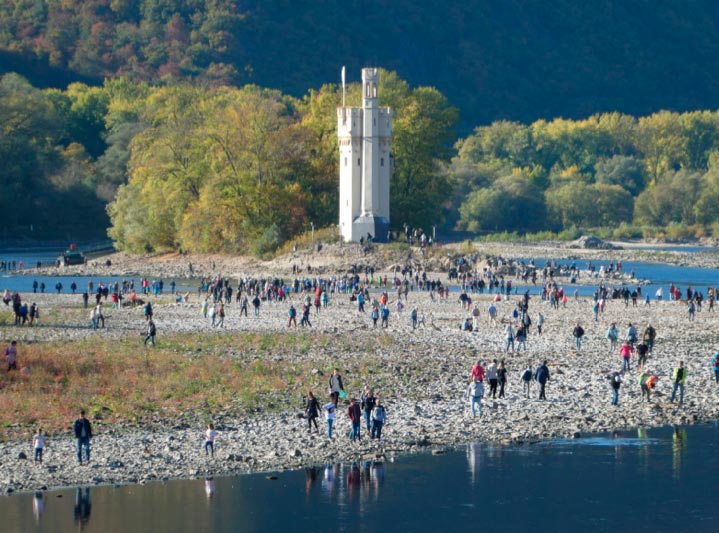
Sunday stroll to the Mäuseturm, generally located on an island in the Rhine between mouth of the river Nahe and the Binger Loch at 21. October 2018 (Foto: Dr. K. Wendling, MUEEF-RLP)
Logistics manager and plant manager at the chemical company
Flow and waterlevel forecasts of the next 6 weeks for the relevant bottleneck
To guarantee raw material supply for the production of chemical goods and the transport of end products.
Numerical weather ensemble predictions are used as input for a hydrological model to produce probabilistic flow and waterlevel forecasts.
Forecasts are used for planning of transport capacities, transport modes (ship, rail, road), stock management and production planning

6-week flow forecast initialized at 19th of November 2018 for gauge Kaub / Rhine. Flow forecasts forced by the weather forecasts of ECMWF in red, forecasts forced by the climatological meteorological forecast (ESP) in blue, observed climatology of the period 1964-2014 in black. Uncertainties of the forecast are displayed as Box-Whisker Plots: the box represents the 25%–75% inter-quantile range, the median is the band inside the box and the whiskers represent the 5% and the 95% quantiles.
On the 19th of November 2018 we are already in a long-lasting extreme low flow period at the River Rhine. Hence, raw material stocks of the chemical company are already low. Continuation of the drought may lead to interruptions of the production of the final chemical product.
In the forecast plot two different forecast approaches (Numerical weather prediction in red, climatological meteorological forecast in blue) compared to the long-term observed flows (black) for the next 6 weeks are presented.
Relevant flow / waterlevel thresholds are defined by the possible draughts of the vessels used to transport the raw materials. E.g. the minimum total draught of the JOWI vessel type is: draught loaded 1,60 m + additional sinkage of a vessel in motion (squat) 0.2 m + under keel clearance (safety margin) 0.4 m = 2.20 m, which corresponds to a waterlevel of 108 cm / flow of 1600 m³/s at gauge Kaub. Below this waterlevel the ship can only operate by reducing the safety margin which is not feasible for tankers carrying liquid raw materials for chemical companies.
In the next three weeks both forecast approaches indicate that water levels will be continuously low, while the following three weeks there is a small probability of higher waterlevels.
Given the forecast of a high probability of insufficient water level conditions with low inland waterway transport capacities in the next weeks, the logistics manager decides to transport raw materials needed urgently for the production by train despite the high costs. As by train not the same amount of raw materials can be transported as by inland waterway transport, an additional decision taken based on the forecast is to reduce the production rate to avoid complete production stop in the near future.